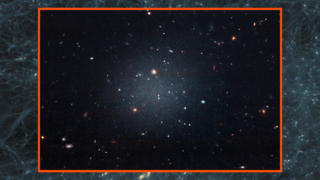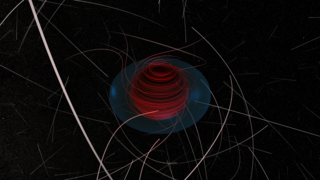Universe
ID: 11894
A new computer simulation tracking dark matter particles in the extreme gravity of a black hole shows that strong, potentially observable gamma-ray light can be produced. Detecting this emission would provide astronomers with a new tool for understanding both black holes and the nature of dark matter, an elusive substance accounting for most of the mass of the universe that neither reflects, absorbs nor emits light.
Jeremy Schnittman, an astrophysicist at NASA's Goddard Space Flight Center, developed a computer simulation to follow the orbits of hundreds of millions of dark matter particles, as well as the gamma rays produced when they collide, in the vicinity of a black hole. He found that some gamma rays escaped with energies far exceeding what had been previously regarded as theoretical limits.
In the simulation, dark matter takes the form of Weakly Interacting Massive Particles, or WIMPS, now widely regarded as the leading candidate class. In this model, WIMPs that crash into other WIMPs mutually annihilate and convert into gamma rays, the most energetic form of light. But these collisions are extremely rare under normal circumstances.
Over the past few years, theorists have turned to black holes as dark matter concentrators, where WIMPs can be forced together in a way that increases both the rate and energies of collisions. The concept is a variant of the Penrose process, first identified in 1969 by British astrophysicist Sir Roger Penrose as a mechanism for extracting energy from a spinning black hole. The faster it spins, the greater the potential energy gain.
In this process, all of the action takes place outside the black hole's event horizon, the boundary beyond which nothing can escape, in a flattened region called the ergosphere. Within the ergosphere, the black hole's rotation drags space-time along with it and everything is forced to move in the same direction at nearly speed of light. This creates a natural laboratory more extreme than any possible on Earth.
Previous work indicated that the maximum gamma-ray energy from the collisional version of the Penrose process was only about 1.3 times the rest mass of the annihilating particles. In addition, only a small portion of high-energy gamma rays managed to escape the ergosphere. These results suggested that a conclusive annihilation signal might never be seen from a supermassive black hole.
However, earlier work made simplifying assumptions about the locations of the highest-energy collisions. Schnittman's model instead tracks the positions and properties of hundreds of millions of randomly distributed particles as they collide and annihilate near a black hole. The new model reveals processes that produce gamma rays with much higher energies, as well as a better likelihood of escape and detection, than ever thought possible. He identified previously unrecognized trajectories where collisions produce gamma rays with a peak energy 14 times the rest mass of the annihilating particles.
The simulation tells astronomers that there is an astrophysically interesting signal they may be able to detect as gamma-ray telescopes improve.
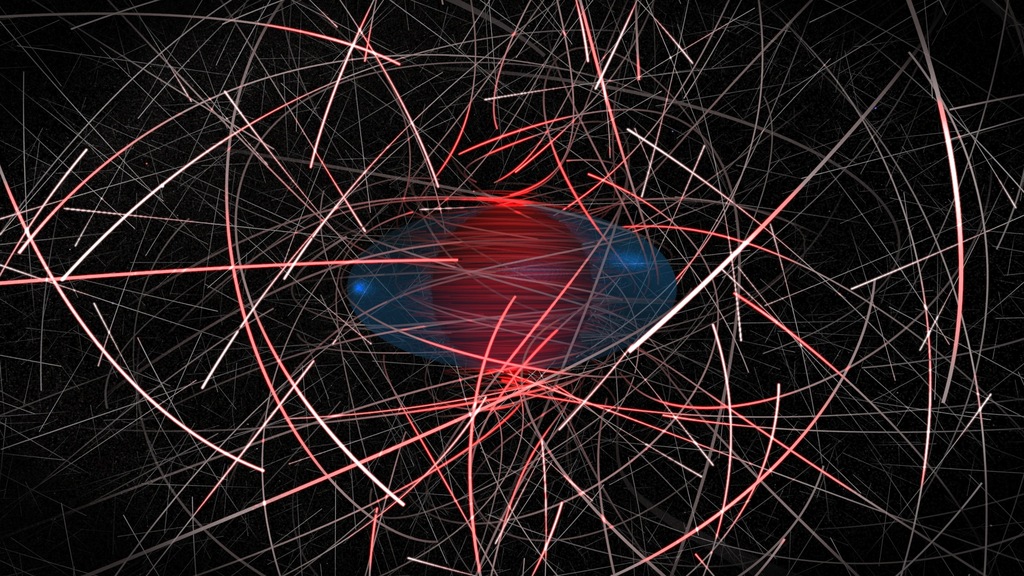

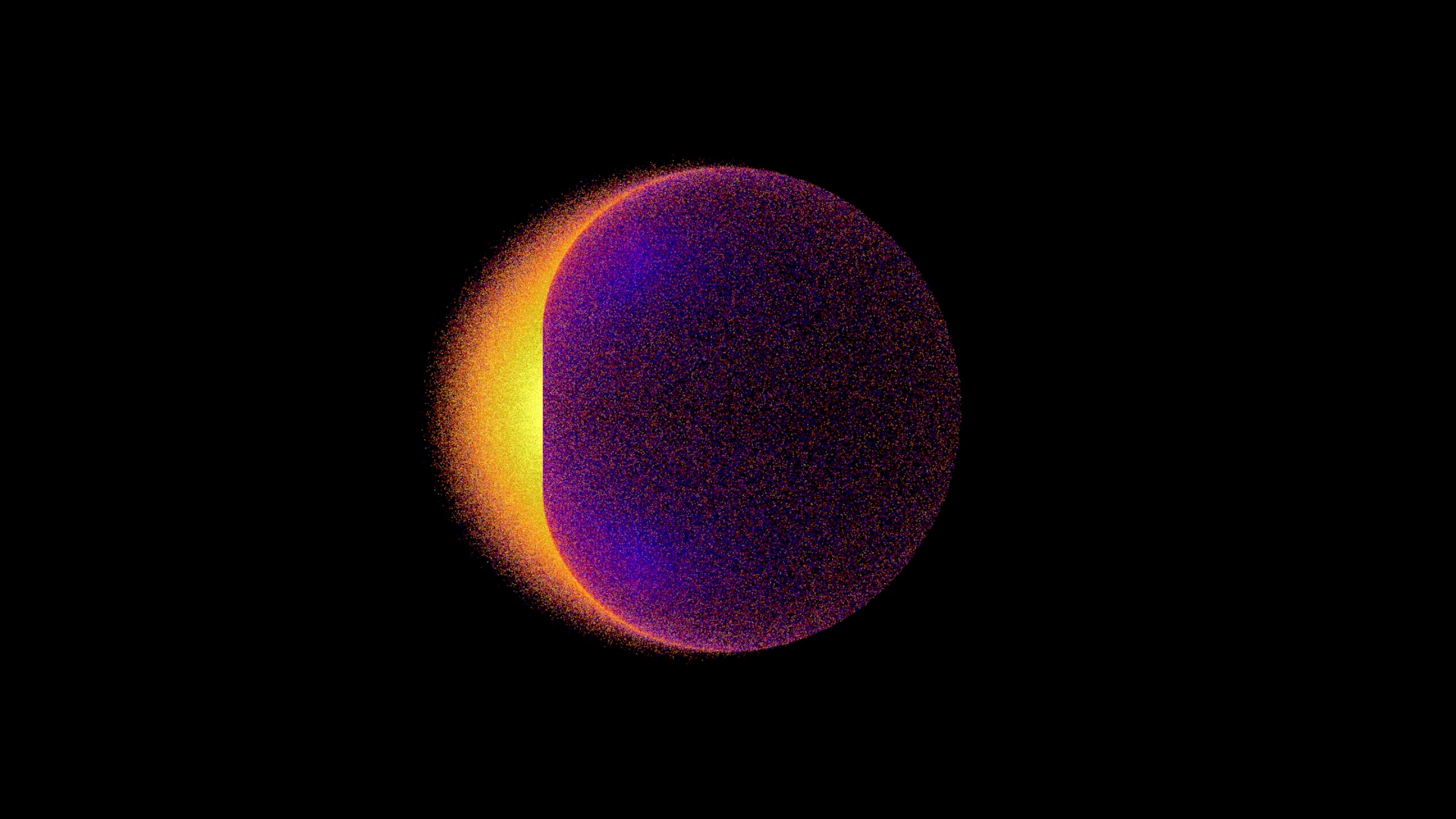
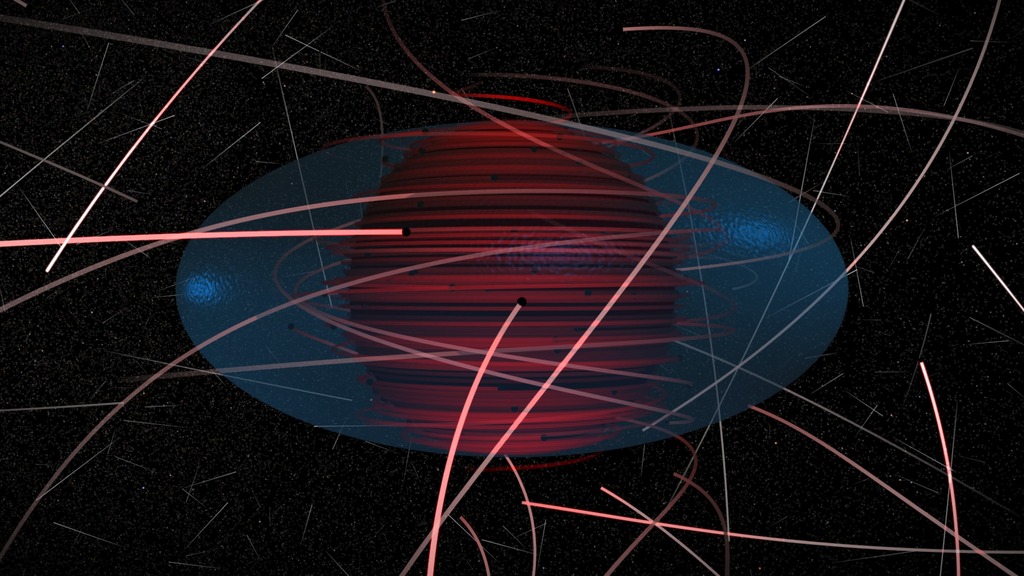
Turning Black Holes into Dark Matter Labs
Jeremy Schnittman, an astrophysicist at NASA's Goddard Space Flight Center, developed a computer simulation to follow the orbits of hundreds of millions of dark matter particles, as well as the gamma rays produced when they collide, in the vicinity of a black hole. He found that some gamma rays escaped with energies far exceeding what had been previously regarded as theoretical limits.
In the simulation, dark matter takes the form of Weakly Interacting Massive Particles, or WIMPS, now widely regarded as the leading candidate class. In this model, WIMPs that crash into other WIMPs mutually annihilate and convert into gamma rays, the most energetic form of light. But these collisions are extremely rare under normal circumstances.
Over the past few years, theorists have turned to black holes as dark matter concentrators, where WIMPs can be forced together in a way that increases both the rate and energies of collisions. The concept is a variant of the Penrose process, first identified in 1969 by British astrophysicist Sir Roger Penrose as a mechanism for extracting energy from a spinning black hole. The faster it spins, the greater the potential energy gain.
In this process, all of the action takes place outside the black hole's event horizon, the boundary beyond which nothing can escape, in a flattened region called the ergosphere. Within the ergosphere, the black hole's rotation drags space-time along with it and everything is forced to move in the same direction at nearly speed of light. This creates a natural laboratory more extreme than any possible on Earth.
Previous work indicated that the maximum gamma-ray energy from the collisional version of the Penrose process was only about 1.3 times the rest mass of the annihilating particles. In addition, only a small portion of high-energy gamma rays managed to escape the ergosphere. These results suggested that a conclusive annihilation signal might never be seen from a supermassive black hole.
However, earlier work made simplifying assumptions about the locations of the highest-energy collisions. Schnittman's model instead tracks the positions and properties of hundreds of millions of randomly distributed particles as they collide and annihilate near a black hole. The new model reveals processes that produce gamma rays with much higher energies, as well as a better likelihood of escape and detection, than ever thought possible. He identified previously unrecognized trajectories where collisions produce gamma rays with a peak energy 14 times the rest mass of the annihilating particles.
The simulation tells astronomers that there is an astrophysically interesting signal they may be able to detect as gamma-ray telescopes improve.




Related
For More Information
Credits
Scott Wiessinger (USRA): Producer
Francis Reddy (Syneren Technologies): Writer
Scott Wiessinger (USRA): Editor
Jeremy Schnittman (NASA/GSFC): Scientist
Tom Bridgman (Global Science and Technology, Inc.): Animator
Scott Wiessinger (USRA): Animator
Chris Meaney (HTSI): Animator
Rob Andreoli (Advocates in Manpower Management, Inc.): Videographer
John Caldwell (Advocates in Manpower Management, Inc.): Videographer
Jeremy Schnittman (NASA/GSFC): Interviewee
Francis Reddy (Syneren Technologies): Writer
Scott Wiessinger (USRA): Editor
Jeremy Schnittman (NASA/GSFC): Scientist
Tom Bridgman (Global Science and Technology, Inc.): Animator
Scott Wiessinger (USRA): Animator
Chris Meaney (HTSI): Animator
Rob Andreoli (Advocates in Manpower Management, Inc.): Videographer
John Caldwell (Advocates in Manpower Management, Inc.): Videographer
Jeremy Schnittman (NASA/GSFC): Interviewee
Please give credit for this item to:
NASA's Goddard Space Flight Center. However, individual items should be credited as indicated above.
NASA's Goddard Space Flight Center. However, individual items should be credited as indicated above.
Short URL to share this page:
https://svs.gsfc.nasa.gov/11894
Mission:
Fermi Gamma-ray Space Telescope
This item is part of these series:
Narrated Movies
Astrophysics Visualizations
Astrophysics Stills
Astrophysics Features
Goddard TV Tape:
G2015-040 -- Dark Matter Black Hole
Keywords:
SVS >> HDTV
SVS >> Simulation
GCMD >> Earth Science >> Spectral/Engineering >> Gamma Ray
SVS >> Black Hole
SVS >> Astrophysics
SVS >> Space
SVS >> Dark Matter
SVS >> Fermi
SVS >> Supercomputer
NASA Science >> Universe
GCMD keywords can be found on the Internet with the following citation: Olsen, L.M., G. Major, K. Shein, J. Scialdone, S. Ritz, T. Stevens, M. Morahan, A. Aleman, R. Vogel, S. Leicester, H. Weir, M. Meaux, S. Grebas, C.Solomon, M. Holland, T. Northcutt, R. A. Restrepo, R. Bilodeau, 2013. NASA/Global Change Master Directory (GCMD) Earth Science Keywords. Version 8.0.0.0.0
https://svs.gsfc.nasa.gov/11894
Mission:
Fermi Gamma-ray Space Telescope
This item is part of these series:
Narrated Movies
Astrophysics Visualizations
Astrophysics Stills
Astrophysics Features
Goddard TV Tape:
G2015-040 -- Dark Matter Black Hole
Keywords:
SVS >> HDTV
SVS >> Simulation
GCMD >> Earth Science >> Spectral/Engineering >> Gamma Ray
SVS >> Black Hole
SVS >> Astrophysics
SVS >> Space
SVS >> Dark Matter
SVS >> Fermi
SVS >> Supercomputer
NASA Science >> Universe
GCMD keywords can be found on the Internet with the following citation: Olsen, L.M., G. Major, K. Shein, J. Scialdone, S. Ritz, T. Stevens, M. Morahan, A. Aleman, R. Vogel, S. Leicester, H. Weir, M. Meaux, S. Grebas, C.Solomon, M. Holland, T. Northcutt, R. A. Restrepo, R. Bilodeau, 2013. NASA/Global Change Master Directory (GCMD) Earth Science Keywords. Version 8.0.0.0.0

